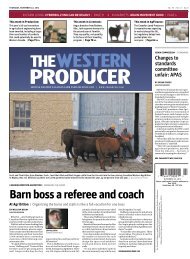Create successful ePaper yourself
Turn your PDF publications into a flip-book with our unique Google optimized e-Paper software.
BEEF | SLAUGHTER<br />
BY ROBERT ARNASON<br />
BRANDON BUREAU<br />
Stephen Koontz has advice for anyone<br />
looking to build a beef slaughter<br />
plant in North America — don’t do it.<br />
“Year in and year out, if I can talk a<br />
producer group out of building a<br />
packing plant, I’ve had a good year,”<br />
said Koontz, an agricultural economics<br />
professor at Colorado State<br />
University.<br />
<strong>Producer</strong> groups or businesses<br />
thinking about building a plant usually<br />
understand that four companies,<br />
Cargill, National Beef, JBS and Tyson,<br />
dominate the beef packing industry<br />
in North America.<br />
Nonetheless, most new entrants<br />
don’t fully comprehend the big four’s<br />
cost advantage, Koontz said.<br />
When asked about the viability of a<br />
$40 million, 250 head per day halal<br />
and kosher slaughter plant that the<br />
Manitoba Cattle Enhancement<br />
Council is proposing for Winnipeg,<br />
Koontz said it’s crucial to understand<br />
the cost per kill of a new plant and<br />
how it correlates to the number of<br />
animals processed.<br />
In a 2007 paper in which he analyzed<br />
packer data, Koontz determined<br />
that the average cost of<br />
slaughter at the four major packers<br />
was $120 to $165 per head, or a mean<br />
of $140 per head. In comparison, the<br />
slaughter cost at smaller plants were<br />
$200 to $375 per head.<br />
Updating the figures to 2012,<br />
Koontz estimated it now costs the big<br />
four $160 to $175 per head.<br />
Assuming that costs have increased<br />
a similar amount for smaller packers,<br />
those plants would now spend $230<br />
to $440 per kill.<br />
As an example of scale in the industry,<br />
Cargill’s packing plant in Dodge<br />
City, Kansas, kills 6,000 animals per<br />
day, but Koontz said even beef plants of<br />
that size must operate at full capacity.<br />
“Packers do make money, but it’s<br />
an extremely low margin business….<br />
<strong>The</strong> critical thing with these plants is<br />
that they’ve got to run two shifts per<br />
day, five days a week and one shift on<br />
Saturday,” Koontz said.<br />
“If you’re looking at any small plant,<br />
they’re usually running one shift per<br />
day, sometimes four days a week.<br />
That just won’t cover the cost of your<br />
building and your people.”<br />
Koontz’s cost estimates are similar<br />
to numbers cited by Canadian Cattlemen’s<br />
Association president Martin<br />
Unrau during a speech in Brandon<br />
in late November.<br />
He said costs are around $165 per<br />
kill at certain JBS plants in the United<br />
States and closer to $400 per kill at<br />
smaller plants.<br />
A CCA spokesperson said in an<br />
email that Unrau’s figures are two<br />
years out of date and can’t be applied<br />
to a proposed slaughter plant such as<br />
the ProNatur project in Winnipeg.<br />
ProNatur spokesperson Adam<br />
Dooley said it’s difficult to compare<br />
this type of project to large commodity<br />
players in the beef industry,<br />
because the Winnipeg plant will target<br />
niche markets.<br />
“We have calculated our cost per<br />
animal and it is competitive,” Dooley<br />
said.<br />
NEWS<br />
Economist advises against slaughter plant<br />
Analyzing costs | Low margins in slaughter plants make business difficult for new and small players<br />
BY BARRY WILSON<br />
OTTAWA BUREAU<br />
Prairie grain farmers are having a<br />
good year, but that should not be<br />
attributed to the end of the CWB<br />
monopoly, says National Farmers<br />
Union president Terry Boehm.<br />
He also argued during a video<br />
appearance before the House of<br />
Commons agriculture committee<br />
Dec. 6 that government changes to<br />
agricultural regulations and rules are<br />
turning the clock back to an era when<br />
farmers were at the mercy of market<br />
forces and powerful monopolies.<br />
During the past century, farmers<br />
have lobbied for and won the right to<br />
have a greater say in the government<br />
Low margins force beef slaughter plants to run at full capacity. | FILE PHOTO<br />
Although cost is a significant factor,<br />
Koontz said another argument<br />
against building a beef slaughter<br />
plant in North America is that existing<br />
facilities aren’t operating at full<br />
capacity.<br />
Based on data from his 2007 study,<br />
Koontz said the industry had approximately<br />
25 percent excess capacity.<br />
A few plants have closed over the<br />
last five years, but the North American<br />
cattle herd has also contracted.<br />
<strong>The</strong>refore, Koontz said excess capacity<br />
may no longer be 25 percent, but<br />
it’s at least 15 percent.<br />
<strong>The</strong> plant in Winnipeg is planning<br />
to sell its beef into the kosher and<br />
halal market, which should partially<br />
compensate for increased killing<br />
costs.<br />
In a study published this year in<br />
Agricultural and Resource Economics<br />
Review, Lee Schulz of Iowa State University<br />
found that steaks with a religious<br />
claim earn a market premium<br />
THE WESTERN PRODUCER | WWW.PRODUCER.COM | DECEMBER 13 , 2012<br />
of $1.18 per lb. compared to steaks<br />
that aren’t kosher or halal.<br />
<strong>The</strong> premium is helpful, but Schulz<br />
determined it’s relatively small compared<br />
to organic beef, which garners<br />
a premium of $2.98 per lb.<br />
Koontz said cost per kill ultimately<br />
determines if a plant succeeds or not.<br />
“It’s really hard to get enough premiums<br />
to offset a higher cost plant,”<br />
he said.<br />
“<strong>The</strong> theory of premiums is great.<br />
But … what market is not being satisfied<br />
now that you’re going to satisfy?<br />
Or whose market are you going to<br />
take away from them?”<br />
Cargill already produces certified<br />
halal beef at its Dunlop plant in<br />
Guelph, Ont., which processes 1,500<br />
head per day.<br />
<strong>The</strong> Islamic Food and Nutrition<br />
Council of America certifies the beef<br />
from the Guelph plant, which is much<br />
closer to the major Canadian markets<br />
for halal beef than Winnipeg.<br />
GRAIN | MARKETING<br />
High grain prices not linked to end of CWB monopoly, says NFU president<br />
Maintaining stance | National Farmers Union president Terry Boehm contends costs for producers will rise<br />
regulatory and co-operative grain<br />
system, the Saskatchewan farmer told<br />
MPs during the first NFU appearance<br />
before the committee in months.<br />
“We’re systematically dismantling<br />
that collaborative system under the<br />
guise of buzzwords like modernization,<br />
rationalization, an assortment of<br />
pieces along that line and really recreating<br />
an adversarial system where<br />
farmers fundamentally end up paying<br />
for all the costs in the system, as they<br />
always have,” said Boehm.<br />
After weeks of testimony about how<br />
this year, with its record grain and<br />
oilseed prices, has been a good one<br />
for prairie farmers, Conservative<br />
MPs pressed Boehm on how farmers<br />
are doing in the aftermath of the<br />
CWB monopoly.<br />
<strong>The</strong> Conservatives pressed for and<br />
eventually won the battle over ending<br />
the CWB monopoly, but the NFU<br />
was one of the strongest defenders of<br />
the single desk.<br />
Peace River Conservative MP Bob<br />
Zimmer said his farmer constituents<br />
have seen positives in the market since<br />
the end of the CWB monopoly Aug. 1.<br />
Are NFU farmer members better off<br />
this year than last year?<br />
“<strong>The</strong> prices are not determined<br />
entirely by single desk or no single<br />
desk or voluntary or otherwise,” said<br />
Boehm. “We have droughts that have<br />
created relatively buoyant prices, so<br />
for the moment farmers are getting<br />
high prices, but you can’t attribute<br />
that to marketing freedom or a voluntary<br />
board.”<br />
Zimmer responded: “It’s been a<br />
good start, I must say.”<br />
On Dec. 4, <strong>Western</strong> Barley Growers<br />
Association director and past president<br />
Brian Otto told MPs on the committee<br />
it was more than a good start.<br />
He said deliveries are at a decade<br />
high level, elevators are moving crop<br />
quickly and railways and export terminals<br />
are turning deliveries around<br />
quickly.<br />
“This is how a commercial marketplace<br />
should work and certainly creates<br />
an atmosphere that will attract<br />
investment into our industry.”<br />
In his testimony, Boehm said his<br />
organization is dedicated to a farm<br />
BY ROBERT ARNASON<br />
BRANDON BUREAU<br />
81<br />
NORTHERN BEEF PACKERS | CATTLE<br />
South Dakota<br />
packing facility<br />
opens doors<br />
It’s been six years since the project<br />
was initially proposed, but a $109<br />
million beef slaughter plant in Aberdeen,<br />
S.D., finally began processing<br />
cattle this fall.<br />
Northern Beef Packers, which is<br />
partially owned by Korean investors<br />
and was built to alleviate a beef processing<br />
gap in the Dakotas, is now<br />
processing cattle. As it scales up production<br />
into 2013 and 2014, plant<br />
managers expect to process 1,500<br />
cattle per day.<br />
If a second shift is added, the<br />
plant’s kill capacity could reach<br />
3,500 per day.<br />
<strong>The</strong> plant plans to buy cattle from<br />
North and South Dakota, Minnesota<br />
and Iowa because producers in<br />
those states now ship cattle south to<br />
plants in Nebraska.<br />
Laure Swanson, Northern Beef<br />
Packers marketing director, told the<br />
Bismarck Tribune that Canadian<br />
producers have expressed interest in<br />
selling cattle to the plant.<br />
Aberdeen, which is about a sixhour<br />
drive south of Winnipeg, may<br />
offer significant transport savings for<br />
Manitoba producers, who normally<br />
sell cattle to plants in Alberta or to<br />
processors hundreds of kilometres<br />
south of Aberdeen.<br />
NORTHERN BEEF<br />
PACKERS PLANS<br />
TO PROCESS 1,500<br />
CATTLE PER DAY.<br />
3,500<br />
CATTLE COULD<br />
BE PROCESSED<br />
IF THE PLANT ADDS<br />
A SECOND SHIFT<br />
model that differs from the large farm<br />
assumption of current policy.<br />
“We believe that small-sized and<br />
medium-sized family farms should<br />
be the fundamental food producing<br />
units in Canada,” he told MPs. “Our<br />
mandate is to work for economic and<br />
social justice for those farmers.”<br />
He said government policies on the<br />
CWB, the Canadian Grain Commission<br />
and the railways are returning<br />
the farm economy to a time when<br />
farmers had less power.<br />
“All of these policies that we’re seeing<br />
are really shifting the clock back<br />
without actually looking at the entire<br />
public good, (without) economic<br />
cost-benefit analysis taking place,”<br />
he said.








